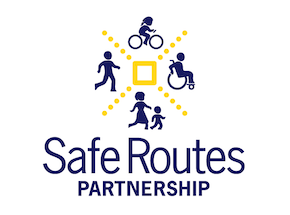This post has been edited to clarify the difference between unobligated funds and awarded funds.
Resource Library
Please join us for the second in our 2021-2022 ATP Webinar Series. The Safe Routes Partnership began hosting webinars for applicants to the Active Transportation Program in Cycle 5, and we are excited to provide another round of webinars in anticipation of Cycle 6.
To mark the launch of our new toolkit, Let’s Get Together: A Guide for Engaging Communities and Creating Change, the Safe Routes Partnership is hosting a free two-part webinar and Zoom networking session.
Join us as we explore strategies for culturally responsive Safe Routes to School programming and what you can do to engage students and families facing barriers to participation like racial and cultural norms, language, and income.
Join us as we dive into engineering strategies for Safe Routes to School projects.
Key takeaways:
- Modifying the built environment to increase walkability and promote physical activity often has the added benefit of reducing the risk of pedestrian injury. However, how to best measure pedestrian injury is not clearly defined in physical activity literature.
- Crash data from police reports include the frequency of pedestrian injury but not the severity.
- Few studies regarding the creation of walkable communities include data that measure the severity of pedestrian injury.
- Due to the strict criteria applied to this research, limited studies were fully evaluated. The studies that were evaluated were categorized by four different interventions:
- The impact of pedestrian countdown timer signals (PCS) on pedestrian motor vehicle collisions (PMVC).
- The use of crash data from police reports to evaluate unsignalized pedestrian crossings and injuries.
- Traffic calming interventions focused on slowing traffic including speed humps, speed bumps, and shared space.
- The impacts of Vision Zero initiatives or comprehensive traffic safety programs, on pedestrian safety.
We at the Safe Routes Partnership hope 2022 is off to a happy, healthy start for you and your communities. We celebrated the passage of the Bipartisan Infrastructure Law (BIL) late in 2021, and now we are here to help you take advantage of the positive policy changes and new money included in the law.
This resource is for individuals, organizations, and government agencies working on equity and engagement in Safe Routes to School and beyond.
Key takeaways:
- This study provides quantitative data supporting a policy of reducing vehicle speed limits to 20 miles per hour (mph).
- Reducing the speed limit causes drivers to slow down.
- Reducing the speed limit does not motivate drivers to change their mode of transportation from driving to active travel. Because there is not a decrease in vehicle volume, the authors infer that the reduction in speed did not increase feelings of safety enough to shift modal choice (i.e., choosing to bike rather than drive).
- Public attitudes toward a 20-mph speed limit policy improved after the intervention while public perceptions of safety did not change.
On Tuesday, January 11th from 11 am to noon Mountain, the Colorado Department of Transportation is hosting a free webinar presented by the Safe Routes Partnership:
Now that the Infrastructure Investment and Jobs Act of 2021 (IIJA) has been signed into law, we are seeing a flurry of excitement about what it means for Safe Routes to School, walking, and bicycling. And we are also seeing uncertainty about what the law requires and what it offers related to Safe Routes to School. In particular, the section that restored the Safe Routes to School program is leading to confusion for advocates and agencies alike. We are here to help you make sense of it what it means, why it happened like this, and what to do about it.
On Tuesday, January 11th from 11 am to 12 pm Mountain, the Colorado Department of Transportation is hosting a free webinar presented by the Safe Routes Partnership:
This resource is for individuals, organizations, and government agencies that are working on community engagement in Colorado.
On Thursday, November 18th from 3pm-4pm CT the Houston Health Department is hosting a free webinar presented by the Safe Routes Partnership:
On November 5, 2021, the House passed the Infrastructure Investment and Jobs Act of 2021. The Senate passed the bill in August, which means it now advances to President Biden to sign into law. Colloquially referred to as “the infrastructure bill”, the Infrastructure Investment and Jobs Act of 2021 is a monumental investment in the safety and support of people walking and bicycling.
While Democrats continue to iron out negotiations on Build Back Better, the partisan human-infrastructure bill, Congress passed another short-term extension for surface transportation on October 28th. This extension runs through December 3, 2021. As a reminder, these short-term extensions keep funding levels and policy unchanged.
On Thursday, October 28th from 3pm-4pm CT the Houston Health Department is hosting a free webinar presented by the Safe Routes Partnership:
Starting and Growing a Strong Safe Routes to School Program
Thursday, October 28th, 3pm-4pm CT
This promotional tookit can be used to disseminate the report, Routes of Health: Exploring the Effects of Navigation Systems on Community Mobility, Safety, and Livability.
This report examines how the increased use of navigation systems is directing drivers into sensitive street zones, shifting traffic patterns and behaviors, creating a culture of health that's threatening active transportation, children’s health & safety, and the vitality of streets surrounding our parks, schools, and other community hubs.
This factsheet offers evaluation techniques for all phases of safe routes efforts as well as how and when they can be most useful so that you can incorporate evaluation from the beginning, rather than solely at the end.

